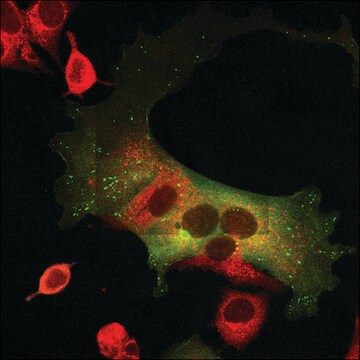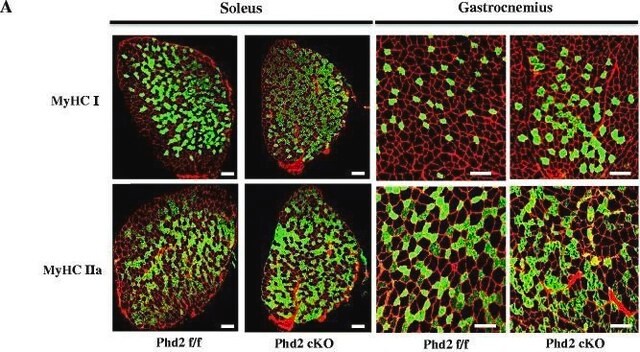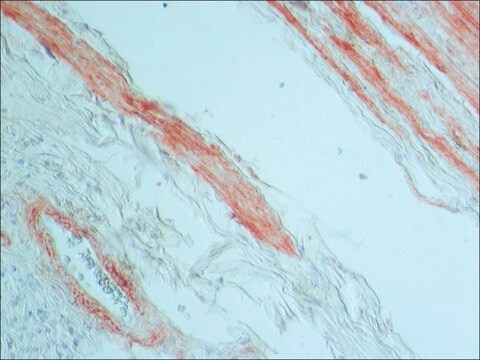추천 제품
생물학적 소스
mouse
Quality Level
결합
unconjugated
항체 형태
ascites fluid
항체 생산 유형
primary antibodies
클론
BIII-136, monoclonal
포함
15 mM sodium azide
종 반응성
human
기술
immunoprecipitation (IP): suitable using human erythrocytes
indirect immunofluorescence: suitable using methanol-fixed human erythrocytes
western blot: 1:5,000 using human erythrocytes
동형
IgG2a
배송 상태
dry ice
저장 온도
−20°C
타겟 번역 후 변형
unmodified
유전자 정보
human ... SLC4A1(6521)
일반 설명
Band 3 is a hydrophobic protein, it exists in erythrocytes as a dimer and tetramer and has a strong tendency to aggregate because of oxidative stress.
Band 3 is an anion exchanger that is abundantly found in erythrocyte membranes. This integral membrane anion exchanger protein regulates mechanical stability and ion homeostasis across the red blood cell membrane. Genetic alterations in Band 3 have been associated with familial distal renal tubular acidosis
Monoclonal Anti-Band 3 antibody detects Band 3 protein (90-100 kD) and several lower molecular mass peptides migrating in SDS-PAGE gels in the regions of 60, 40 and 20 kD. The product specifically binds to the cytoplasmic amino-terminal protein of band 3 (the epitope is approx. 20 kD from the N-terminal end). As the epitope is not located at the erythrocyte surface, the antibody product does not agglutinate red blood cells. Furthermore, its cell surface binding cannot be detected by an indirect agglutination assay. The antibody does not localize Band 3 from horse, bovine, pig, guinea pig, dog or mouse erythrocytes, nor does it localize Band 3 from nonerythroid human fibroblast extract.
Monoclonal Anti-Band 3 antibody detects Band 3 protein (90-100 kD) and several lower molecular mass peptides migrating in SDS-PAGE gels in the regions of 60, 40 and 20 kD. The product specifically binds to the cytoplasmic amino-terminal protein of band 3 (the epitope is approx. 20 kD from the N-terminal end). As the epitope is not located at the erythrocyte surface, the antibody product does not agglutinate red blood cells. Furthermore, its cell surface binding cannot be detected by an indirect agglutination assay. The antibody does not localize Band 3 from horse, bovine, pig, guinea pig, dog or mouse erythrocytes, nor does it localize Band 3 from nonerythroid human fibroblast extract.
특이성
The antibody recognizes an epitope located in the cytoplasmic N-terminus of the band 3 molecule/proteins (90-100kDa).
면역원
Glycophorin B from human erythrocytes.
애플리케이션
Monoclonal Anti-Band 3 antibody can be used for western blot, immunoprecipitation and indirect immunofluorescence using human erythrocytes.
Monoclonal Anti-Human Band 3 has been used in immunoblotting. It may also be used in the study of red cell structures and functions and to study the fragmentation of the cytoplasmic domain of band 3 protein in vivo and in vitro.
Monoclonal anti-Band 3 antibodies can be used in ELISA and immunoprecipitation. It may also be used for immunofluorescent staining.
생화학적/생리학적 작용
Band 3, a 90-100kD protein is the major integral protein of human erythrocytes responsible for anion exchange. It also regulates the intracellular pH. Monoclonal anti-Band 3 antibody is useful in in vivo and in vitro study of fragmentation of cytoplasmic domain of band 3 protein. It may also be used for immunoblot analysis. Monoclonal Anti-Human Band 3 antibody reacts specifically with cytoplasmic N-terminal band 3 proteins (90-100kD).
면책조항
Unless otherwise stated in our catalog or other company documentation accompanying the product(s), our products are intended for research use only and are not to be used for any other purpose, which includes but is not limited to, unauthorized commercial uses, in vitro diagnostic uses, ex vivo or in vivo therapeutic uses or any type of consumption or application to humans or animals.
적합한 제품을 찾을 수 없으신가요?
당사의 제품 선택기 도구.을(를) 시도해 보세요.
Storage Class Code
10 - Combustible liquids
WGK
nwg
Flash Point (°F)
Not applicable
Flash Point (°C)
Not applicable
시험 성적서(COA)
제품의 로트/배치 번호를 입력하여 시험 성적서(COA)을 검색하십시오. 로트 및 배치 번호는 제품 라벨에 있는 ‘로트’ 또는 ‘배치’라는 용어 뒤에서 찾을 수 있습니다.
Mohammad Al-Ansari et al.
BMC hematology, 15, 17-17 (2015-12-22)
Glucose-6-phosphate dehydrogenase (G6PD) deficiency is associated with erythrocyte sensitivity to oxidative damage and hemolytic crises. In β-thalassemia major, where hemoglobin instability imposes oxidative stress, erythrocytes show reduced hENT1 nucleoside transporter expression and decreased nucleoside uptake. This study investigated hENT1 expression
Daan Vorselen et al.
Nature communications, 9(1), 4960-4960 (2018-11-25)
Extracellular vesicles (EVs) are widely studied regarding their role in cell-to-cell communication and disease, as well as for applications as biomarkers or drug delivery vehicles. EVs contain membrane and intraluminal proteins, affecting their structure and thereby likely their functioning. Here
L J Bruce et al.
Biochemistry and cell biology = Biochimie et biologie cellulaire, 76(5), 723-728 (1999-06-03)
In distal renal tubular acidosis (dRTA) the tubular secretion of hydrogen ion in the distal nephron is impaired, leading to the development of metabolic acidosis, frequently accompanied by hypokalemia, nephrocalcinosis, and metabolic bone disease. The condition can be familial, when
E Lecarpentier et al.
PloS one, 11(1), e0147262-e0147262 (2016-01-28)
In the human placenta the maternal blood circulates in the intervillous space (IVS). The syncytiotrophoblast (STB) is in direct contact with maternal blood. The wall shear stress (WSS) exerted by the maternal blood flow on the STB has not been
Reduced PKC α Activity Induces Senescent Phenotype in Erythrocytes.
Govekar, R., B., et al.
Anemia, doi:10-doi:10 (2012)
자사의 과학자팀은 생명 과학, 재료 과학, 화학 합성, 크로마토그래피, 분석 및 기타 많은 영역을 포함한 모든 과학 분야에 경험이 있습니다..
고객지원팀으로 연락바랍니다.







